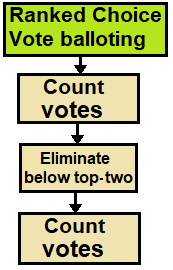Our website is made possible by displaying online advertisements to our visitors.
Please consider supporting us by disabling your ad blocker.
Contingent vote

| A joint Politics and Economics series |
| Social choice and electoral systems |
|---|
 |
|
|
The contingent vote is an electoral system used to elect a single representative in which a candidate requires a majority of votes to win. It is a form of preferential voting. The voter ranks the candidates in order of preference, and when the votes are counted, the first preference votes only are counted. If no candidate has a majority (more than half) of the votes cast, then all but the two leading candidates are eliminated and the votes received by the eliminated candidates are distributed among the two remaining candidates according to voters' preferences.
The contingent vote can be considered a compressed or "instant" form of the two-round system (runoff system), in which both "rounds" occur without the need for voters to go to the polls twice. For this reason, the term instant-runoff voting has also been used for this method,[citation needed] though this conflicts with the more common meaning.
It also has similarities to other ranked-choice systems. Unlike the contingent vote, systems like instant-runoff voting (IRV), Coombs' method, and Baldwin's method allow for many rounds of counting, eliminating only one weakest candidate each round. IRV allows a candidate other than the top two in the first count to win.
Previous Page Next Page


